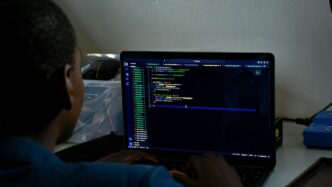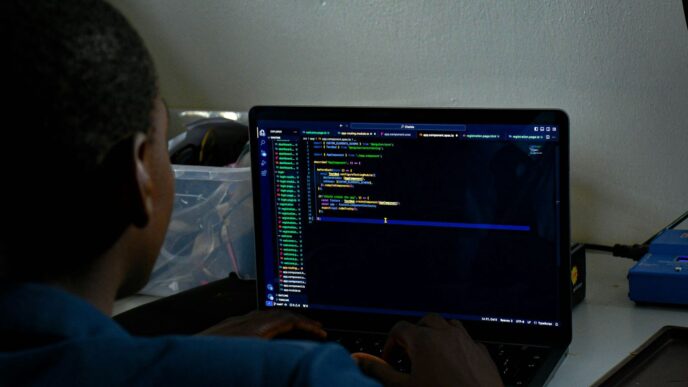Getting ready for coding interviews can feel like a big task, and figuring out the best way to tackle LeetCode is a common question. Many people find that using Python for their LeetCode solutions really helps speed things up. It’s not just about writing code; it’s about thinking clearly and showing what you know. This article looks at why Python is a great choice for LeetCode and how it can help you get ready for interviews.
Key Takeaways
- Python’s simple syntax means you spend less time on code details and more time on solving problems, which is great for LeetCode.
- Built-in tools like lists, dictionaries, and sets in Python make it easy to work with data structures needed for many LeetCode challenges.
- Python’s readability makes it simpler to understand complex algorithms and explain your thought process during interviews.
- The LeetCode community often shares solutions and discussions in Python, making it easier to learn from others.
- Practicing with Python on LeetCode helps build good coding habits, like writing clear and organized code, which interviewers notice.
Why Python Is The Premier Choice For LeetCode Solutions
When you’re diving into LeetCode, picking the right programming language can make a big difference. For many, Python just clicks. It’s not just about personal preference, though. There are solid reasons why Python has become a go-to for tackling these kinds of coding challenges.
Focus on Algorithms, Not Syntax
Let’s be real, the whole point of LeetCode is to get good at solving problems using algorithms. You don’t want to spend hours wrestling with complicated syntax or writing tons of boilerplate code. Python really shines here. Its syntax is clean and reads almost like plain English, which means you can express your ideas more directly. Think about a simple task like traversing a binary tree. In Python, you can often write the whole solution in fewer than 10 lines, and it’s easy to follow. Compare that to other languages where you might need 20 lines just to set up the function. This lets you concentrate on the actual logic, not the language mechanics. It’s about building your problem-solving muscles, not memorizing obscure language rules.
Leveraging Python’s Built-In Data Structures
Many LeetCode problems involve working with common data structures like lists, dictionaries, or sets. Python comes with these built-in, and they’re super efficient. Need a queue or a stack? Python’s list or collections.deque has you covered. Want a fast way to look things up? Dictionaries (dict) and sets (set) are your friends. There’s even heapq for priority queues. This means you’re not spending your valuable prep time building these structures from scratch. You can just use them, which is a huge time-saver, especially when you’re practicing under timed conditions. It’s like having a toolbox already stocked with the best tools, so you can get straight to the job. This efficiency is a big reason why so many people find success on platforms like LeetCode.
Accelerated Learning Through Fast Feedback Loops
Learning is all about trying things out and seeing what works. Python makes this process much faster. You can quickly test out small pieces of code, either in an interactive interpreter or a notebook. When something goes wrong, Python’s error messages are usually pretty clear and helpful. You spend less time waiting for code to compile and more time iterating on your solutions. This rapid feedback loop is fantastic for learning. You can experiment with different approaches, debug effectively, and really get a feel for how algorithms work without getting bogged down by the language itself. It makes the whole practice process less frustrating and way more productive.
Mastering Algorithmic Challenges With Python
Simplifying Complex Problems: Math-Heavy and Algorithmic Tasks
When you’re staring down a LeetCode problem, especially one that involves a lot of math or tricky algorithms like dynamic programming or recursion, Python can really make things feel less daunting. Its syntax is pretty close to how you’d write out the steps in plain English, or pseudocode, which is a huge help when you need to explain your thinking later on. Things like lists that can grow as big as you need them to, or easy ways to slice up strings and lists, just make the code cleaner. You can also use handy tools like map and filter to write your solutions in a more elegant way. This means you spend less time fighting the language and more time actually solving the problem.
The Power of Python’s Syntax for Readability
Let’s be honest, nobody likes wading through code that looks like a tangled mess. Python’s design really pushes for clear, readable code. This isn’t just about making your own life easier when you come back to a problem; it’s super important for interviews. When you can write code that’s easy to follow, you can explain your logic more effectively to the interviewer. It’s like writing a story where each step makes sense. This clarity also helps when you’re debugging, which, let’s face it, happens a lot.
Visualizing Execution for Deeper Understanding
Sometimes, especially with recursive problems or dynamic programming, just looking at the code isn’t enough. You need to see what’s actually happening step-by-step. Tools like Python Tutor are fantastic for this. You can literally watch your code execute line by line, seeing how variables change and how function calls stack up. I remember struggling with depth-first search (DFS) and backtracking problems. Being able to visually trace each recursive call made the whole concept click in a way that just reading about it never did. It’s a game-changer for those head-scratching algorithmic challenges.
Leveraging The LeetCode Community With Python
When you’re grinding away on LeetCode, it’s easy to feel like you’re in a solo mission. But honestly, you’re not. The LeetCode community is huge, and a lot of people are using Python to tackle these problems. This is actually a pretty big deal for your learning.
Accessing High-Quality Python Solutions
Ever get stuck on a problem and just stare at it? Happens to me all the time. The good news is, if you’re using Python, you’re in luck. A ton of the top-rated solutions you’ll find on LeetCode are written in Python. Why? Because Python lets people write code that’s pretty easy to read, almost like plain English sometimes. This means when you look at someone else’s solution, you can actually understand what they did without needing a decoder ring. It’s like having a cheat sheet, but a really smart one.
The Community’s Favor Towards Python
It’s not just about the solutions themselves; it’s about how people talk about them. If you browse through the discussion forums on LeetCode, you’ll notice Python pops up a lot. People share their thought processes, explain tricky algorithms, and offer tips, and they often do it in Python. This makes it way easier to follow along and pick up new tricks. It feels like the community just naturally gravitates towards Python for sharing knowledge, and that’s a win for you.
Learning From Top-Rated Python Discussions
So, what does this mean for your practice? It means you can learn a lot faster. When you’re stuck, you can look up the problem, find the most upvoted solutions, and see how others solved it using Python. You can also read the comments and discussions to get different perspectives. It’s like having a study group, but one that’s available 24/7 and full of people who’ve already figured things out. You can even try to explain a solution yourself in Python, which is a great way to solidify your own understanding.
Developing Interview-Ready Habits With Python
Alright, so you’ve been grinding on LeetCode, tackling those algorithmic puzzles. That’s awesome. But how do you make sure all that practice actually translates into acing that job interview? It’s not just about getting the right answer; it’s about how you get there and how you show your work. And honestly, Python really helps with this.
Writing Clean and Readable Code
Think about it: when you’re in an interview, the person across from you needs to follow your thought process. If your code looks like a tangled mess, they’re going to get lost, and so will your chances. Python’s syntax is pretty straightforward, which naturally pushes you towards writing code that’s easier to read. It’s less about remembering obscure symbols and more about expressing your logic clearly. This focus on clarity is a huge win for interview performance.
When you practice writing solutions in Python, you’re building a habit of making your code self-explanatory. This means:
- Meaningful Variable Names: Instead of
xandy, you’ll useuser_countormax_score. It just makes sense. - Logical Structure: Python encourages breaking down problems into smaller, manageable functions. This makes your overall solution much easier to follow.
- Comments When Needed: While Python’s readability often reduces the need for excessive comments, you’ll still learn to add them for those tricky bits that might not be immediately obvious.
Practicing for Real-World Scenarios
LeetCode problems are often simplified versions of real-world challenges. By consistently practicing, especially with Python, you’re not just memorizing solutions; you’re building an intuition for problem-solving. You start to recognize patterns, like when a hash map would be perfect for quick lookups or when a queue is the right tool for a breadth-first search.
Python’s built-in data structures are a big part of this. You don’t have to spend precious interview time implementing a linked list from scratch. You can just use Python’s list or collections.deque and focus on the algorithm itself. This efficiency is exactly what interviewers are looking for – someone who can quickly and effectively apply the right tools.
Improving Communication Through Clear Code
This ties back to readability. When you can explain your Python code easily, you’re demonstrating strong communication skills. Imagine this scenario:
- Problem Understanding: You read the problem, maybe jot down some notes or examples.
- Approach Discussion: You explain your intended solution to the interviewer before you start coding. Python’s clear syntax makes this explanation much smoother.
- Coding: You write your Python code, and because it’s clean, the interviewer can follow along.
- Explanation: You walk through your code, explaining the logic, data structures, and time/space complexity. This is where readable Python really shines.
By practicing this entire flow with Python on LeetCode, you’re not just preparing for the technical aspects of an interview; you’re also honing your ability to articulate your solutions clearly and confidently. It’s about showing them not just that you can code, but that you can explain your code effectively.
Strategic LeetCode Solutions Python Approach
Understanding Problem Complexity
Before you even start coding, it’s super important to figure out what kind of problem you’re dealing with. Is it a simple search, a sorting task, or something more involved like dynamic programming? Knowing this helps you pick the right tools. For instance, if you’re looking at a problem that involves finding pairs that add up to a specific number, like the classic Two Sum problem, you might initially think of checking every single pair. This brute-force method, while straightforward, can be slow for large inputs. Python’s dictionaries (hash maps) offer a much quicker way to solve this by storing seen numbers and checking for complements in near-constant time. The key is to analyze the constraints and potential input sizes to avoid inefficient solutions.
A Structured Roadmap for LeetCode Practice
Jumping into LeetCode without a plan can feel overwhelming. It’s better to have a roadmap. Start with the basics and gradually move to harder topics. A good approach might look something like this:
- Easy Problems: Get comfortable with fundamental data structures like arrays, strings, and linked lists. Problems like "Two Sum" are great starting points.
- Medium Problems: Tackle more complex algorithms, including tree traversals, graph basics, and dynamic programming introductions.
- Hard Problems: Challenge yourself with advanced algorithms, intricate DP problems, and graph algorithms.
Focusing on specific categories or patterns can also help. For example, dedicating a week to just array manipulation problems or recursion can build solid understanding.
The Importance of Consistent Practice
Honestly, nobody gets good at LeetCode overnight. It takes time and regular effort. Even just 30 minutes a day can make a huge difference over weeks and months. Consistency helps you build muscle memory for common patterns and keeps the concepts fresh in your mind. It’s like learning any new skill; the more you do it, the better you become. Don’t get discouraged if you get stuck on a problem; that’s part of the learning process. Sometimes, stepping away and coming back later with a fresh perspective is all you need. You can find a lot of helpful resources and discussions on LeetCode itself, which can guide your practice.
Advanced Python Techniques for LeetCode
Okay, so you’ve got the basics down, and you’re ready to tackle some of the trickier problems on LeetCode. Python can really help you here, especially with some more involved techniques. It’s not just about writing code faster; it’s about expressing complex ideas more clearly.
Dynamic Programming Explained
Dynamic programming (DP) is a way to solve problems by breaking them down into smaller, overlapping subproblems. You solve each subproblem just once and store its result, usually in an array or a dictionary. When you encounter that same subproblem again, you just look up the answer instead of recalculating it. This can make a huge difference in performance, especially for problems that would otherwise take ages to compute.
Think about the classic "coin change" problem. You want to find the minimum number of coins to make a certain amount. A naive approach might try every single combination, which gets out of hand quickly. With DP, you build up a solution. You figure out the minimum coins for amount 1, then for amount 2, and so on, using the results you’ve already found. Python’s clean syntax makes it pretty straightforward to set up these DP tables.
Exploring Common Algorithms and Data Structures
Beyond DP, there are other algorithms and data structures that pop up a lot on LeetCode, and Python handles them nicely.
- Hash Maps (Dictionaries): These are your go-to for fast lookups. If a problem involves checking if you’ve seen something before or counting occurrences, a dictionary is usually the answer. Python’s
dictis super efficient for this. - Tries: Useful for problems involving strings, like prefix matching or autocomplete. While not built-in, implementing a Trie in Python is quite manageable.
- Heaps (Priority Queues): Python’s
heapqmodule gives you min-heap functionality. Need to keep track of the smallest or largest elements efficiently? A heap is your friend. - Graphs: Representing graphs and traversing them (like with Breadth-First Search or Depth-First Search) is common. Python’s lists of lists or dictionaries can represent adjacency lists, and recursive or iterative DFS/BFS are pretty clean to write.
Bit Manipulation and Hashing Strategies
Sometimes, the most efficient solutions involve thinking at the bit level or using clever hashing. Bit manipulation can be used for things like checking if a number is a power of two, counting set bits, or even implementing sets more compactly. Python’s integers have arbitrary precision, which is nice, but you still need to be mindful of how bitwise operators work.
Hashing is also key. Beyond dictionaries, you might encounter problems where you need to design your own hash function or use techniques like rolling hashes for string matching. Understanding how hash functions work and their potential pitfalls (like collisions) is important for solving these problems efficiently and correctly.
Wrapping Up Your LeetCode Journey
So, we’ve gone through a bunch of LeetCode problems and how to tackle them using Python. It’s not always easy, and sometimes you’ll get stuck, but that’s part of the process. Remember, the goal isn’t just to solve problems, but to get better at thinking through them. Python really helps here because it lets you focus on the logic instead of getting bogged down in complicated code. Keep practicing, keep learning from others, and you’ll definitely see progress. You’ve got this!
Frequently Asked Questions
Why is Python a good choice for LeetCode?
Python is super helpful for LeetCode because it lets you focus on solving problems instead of getting stuck on complicated code rules. Its simple language and built-in tools make it quick to write and test your ideas, which is great for practicing and for actual interviews.
How does Python help with difficult coding problems?
When problems get tricky, like those involving lots of math or step-by-step thinking, Python’s clear writing style is like a secret weapon. It often looks like plain English, making it easier to figure out and explain your solutions, even for tough stuff like dynamic programming.
Can I learn from others using Python on LeetCode?
Absolutely! Many of the best and clearest solutions shared by other users on LeetCode are written in Python. This means you can easily learn new tricks and better ways to code by looking at what others have done.
Does using Python prepare me for job interviews?
Yes! Practicing with Python on LeetCode helps you write code that’s neat and easy to understand, which is exactly what interviewers want to see. It also makes it simpler to explain your thinking process out loud during a real interview.
What’s the best way to practice LeetCode with Python?
Start by understanding what the problem is asking. Then, make a plan for how you’ll solve it. The most important thing is to practice regularly. Even solving a few problems each day makes a big difference over time.
Are there advanced Python tricks for LeetCode?
Definitely. Python has cool ways to solve problems faster, like dynamic programming (where you save answers to reuse them) and clever uses of bit manipulation (working with the computer’s basic on/off signals). Learning these can make you a coding superstar.














